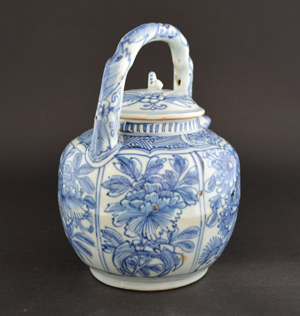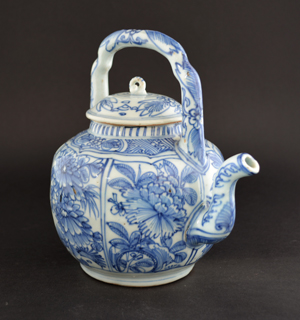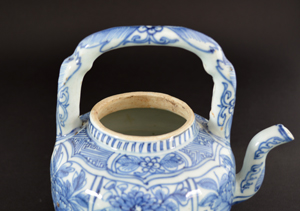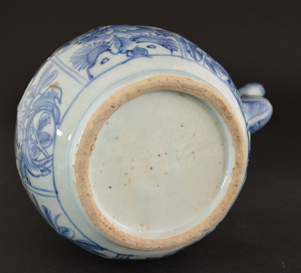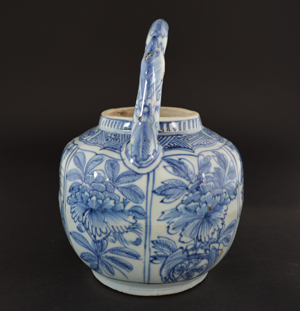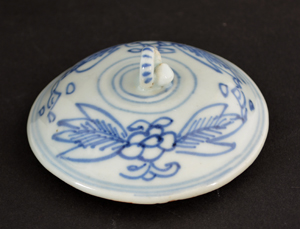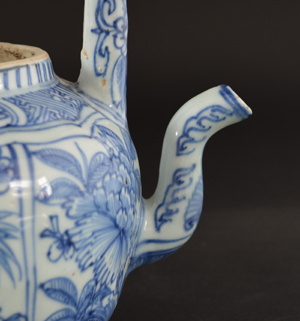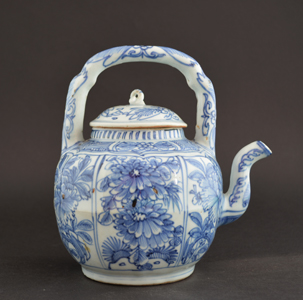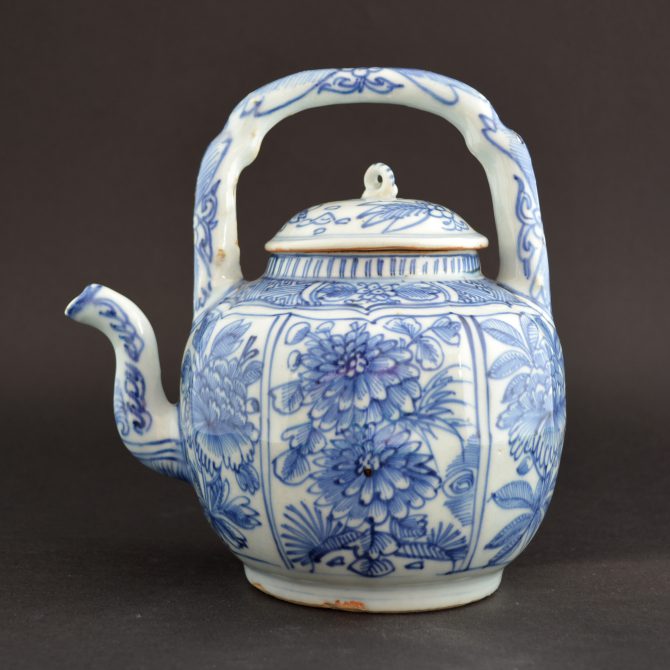
WANLI or TIANQI c.1600 – 1627 Ming Porcelain
A Ming Blue and White Kraak Porcelain Wine Ewer, Wanli (1573-1620) or Tianqi (1621-1627). Painted in a Strong Tone of Cobalt Blue in the `Pencilled` Style. Decorated with Panels of Flowering Peony.
SOLD
- Condition
- In excellent condition, there is a glaze line corresponding to a luting line around the middle of the wine pot and vertically up the spout.
- Size
- Height : 19 cm (7 1/2 inches)
- Provenance
- Christie`s Amsterdam, October 16th 1990, lot 12. A Dutch Noble Family.
- Stock number
- 24291
- References
- For three Ming Kraak Ware Porcelain wine pots of this type see : Kraak Porcelain, A Moment in the History of Trade (Maura Rinaldi, Bamboo Publishing,1989) Pages 182-183 Shape I.4: wine pots. For another Ming winepot of this type see : Transitional Wares and Their Forerunners (The Oriental Ceramic Society of Hong Kong, 1981) Page 82 Item 27. Dated to c.1610 - 1620. A further Ming porcelain wine ewer of this form and design was recovered from the wreck of the Dutch ship Witte Leeuw of 1613. See : The Ceramic Load of the Witte Leeuw 1613 (Edited by C.L van der Pijl-Ketel, Rijksmuseum, Amsterdam, 1982, ISBN 90-9309-6) pages 128 and 129. The catalogue illustrates a related wine ewer from a Flemish painting in the National Gallery in London dated to c.1620 on page 34. A Ming blue and white porcelain wine pot of this type but with tonal painting of a slightly earlier type dated to 1590-1619 is illustrated in `Ming Blue and White Porcelain, The Drs.A.M. Sengers Collection (S.Marchant & Son, November 2001) page 72, plate 51. A Ming porcelain wine pot of this type is in the Topkapi Museum see : Chinese Ceramics in the Topkapi Saray Museum Istanbul, A Complete Catalogue II, Yuan and Ming Porcelains (Regina Krahl, Sotheby`s 1986) page 757 plate 1403. For a Ming porcelain ewer of this shape and design see our `Sold Items` number 20120 and another similar one 23473.
Information
Kraak Ware / Kraak Porcelain :
Kraak Porcelain is a Type of Chinese Export Porcelain Produced from the Wanli period (1573-1620) until the end of the Ming Dynasty in the 1640`s. Kraak ware or Kraak porcelain was the first Chinese Export Ware to arrive in Europe in large quantities. Its name does not, as had been previously thought derived from the name of Portuguese trading ships, it is possible its name derived from Irish ships called Curachs. These trading ships worked between Ireland and England, they were know to the Dutch traders who used a similar word, craquen, to describe Portuguese trading ships. However in the 16th and early 17th centuries the word Kraak was not used in the V.O.C. record or inventories to describe porcelain. The first known time Kraak was first used as a term to describe a type of late Ming blue and white porcelain was in 1673. This was over 100 years after what we now know as Kraak porcelain was first produced, however there is some evidence that it was a term that had been in use for some time. Blue and white porcelain was exported to Europe in large quantities from the mid 16th century. It was highly prized and the Portuguese fort hard against the Dutch to keep control of this lucrative trade, but in 1602 the Dutch sold the cargo they captured from the Portuguese Carrack `San Tiago` and two years later they sold the cargo of the `Santa Catarina`. These ships caused a sensation, it was the first time such large amounts of Chinese blue and white porcelain had been avalible in Northern Europe, many of the pieces were `gifts` rather than to be sold on the open market . All Kraak porcelain was made at the main ceramic centre in China, Jingdezhen. It does vary in style and quality to quite a large extent, and some scholars include pieces as kraakware that others do not, so a definitive description is, I feel, rather difficult. The main group of kraak porcelain is less controversial. Normally thinly potted, often moulded, it`s designs are divided into decorative panels, with reserves that might include flowers and animals, taotie masks and stylised tulips. The bases often show `Chatter Marks`. These are ridges, that radiate from the centre of the base to the foot rim, they are caused by the potters finishing tool catching on the leather hard clay prior to glazing. When one looks at the construction, painting techniques and glazing of kraak porcelain it appears similar in many ways to some of the late Ming porcelain made for the Japanese market. I think it is quite possible that they were both made within the same kilns at Jingdezhen. Kraak porcelain also includes a few rare pieces that have the addition of underglaze copper red and there are a very few know examples of polychrome kraakware. Kraak porcelain went out of fashion at the end of the Ming Dynasty but was later revived during the reign of Kangxi (1662-1722). Swatow porcelain (c.1580-1640) was made in the kraak style but this is thicker and much cruder, the bases often show grit adhering.
Peony :
Peonies are the most commonly encountered flower on Chinese porcelain, indeed in Chinese art in general. There are two cultivated types of peony commonly depicted, the tree peony Paeonia Suffruicosa (Mudan) and the herbaceous peony P.Lactiflora (Shaoyao). Both have rich exuberant flowers with thin silk like petals but the plants are rather different to each other. The tree peony is not in fact a tree but a deciduous shrub, sometimes rather large and sprawling, it has irregular woody stems. It shares a similar leaf and flower form to the herbaceous peony but they are not close in other ways. The Chinese refer to the peony as the `King of flowers` and are seen as equivalent to the first rank among officials. The flowers are closely associated with royalty because they have been grown in imperial gardens since the Sui dynasty (581-618). The peony is one of the flowers of the four seasons and represents the Spring. It symbolizes wealth and honour, honour in the sense of high rank, having an official position, or high social status.
